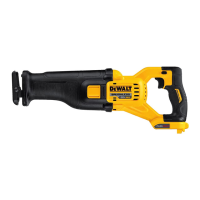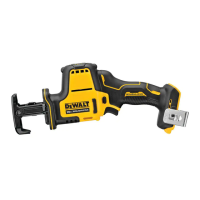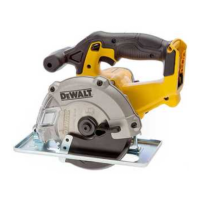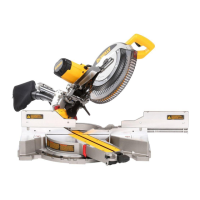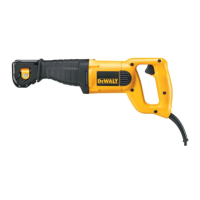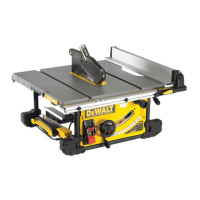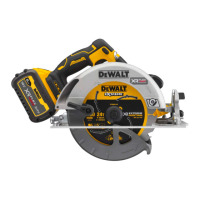14
ENGLISH
Mounting the Dust Extraction Port (Fig. A, H)
Your circular saw is supplied with a dust extractionport.
To Install the Dust Extraction Port
1. Fully loosen depth adjustment lever
4
.
2. Place the shoe
5
in the lowestposition.
3. Push the dust extraction port
22
onto the circular saw
body until the locks engage the dust extraction port and an
audible click isheard.
Mounting and Adjusting the Parallel
Fence (Fig. P)
The parallel fence
25
is used for cutting parallel to the edge of
theworkpiece.
Mounting
1. Slacken the parallel fence adjustment knob
26
to allow the
parallel fence topass.
2. Insert the parallel fence
25
in the base plate asshown.
3. Tighten the parallel fence adjustment knob
26
.
Adjusting
1. Slacken the fence adjustment knob
26
and set the parallel
fence
25
to the desired width.The adjustment can be read
on the parallel fencescale.
2. Tighten the fence adjustment knob
26
Kerf Indicator (Fig. A)
The front of the saw shoe has a kerf indicator
9
for vertical
and bevel cutting. This indicator enables you to guide the saw
along cutting lines penciled on the material being cut. The kerf
indicator lines up with the left (inner) side of the saw blade,
which makes the slot or “kerf” cut by the moving blade fall to
the right of the indicator. Guide along the penciled cutting line
so that the kerf falls into the waste or surplusmaterial.
Bevel Angle Adjustment (Fig. A, L)
The full range of the bevel adjustment is from 0° to 50°. The
quadrant is graduated in increments of 1°. On the front of the
saw is a bevel angle adjustment mechanism consisting of a
calibrated quadrant and a bevel adjustment lever
10
.
To Set the Saw for a Bevel Cut
1. Loosen (counterclockwise) the bevel adjustment lever
10
and tilt shoe (
5
, Fig.A) to the desired angle by aligning the
pointer with the desired anglemark.
2. Retighten lever firmly (clockwise).
Cutting Depth Adjustment (Fig. A, K)
1. Hold the saw firmly and loosen (clockwise) the depth
adjustment lever
4
and move shoe (
5
, Fig.A) to obtain the
desired depth ofcut.
2. Make sure the depth adjustment lever has been retightened
(counterclockwise) before operatingsaw.
For the most efficient cutting action, set the depth adjustment
so that one‑half tooth of the blade will project below the
material to be cut. This distance is from the tip of the tooth to
Blades
WARNING: To minimize the risk of eye injury, always
use eye protection. Carbide is a hard but brittle material.
Foreign objects in the workpiece such as wire or nails
can cause tips to crack or break. Only operate saw when
proper saw blade guard is in place. Mount blade securely
in proper rotation before using, and always use a clean,
sharpblade.
WARNING: Do not cut metal, plastic, concrete, masonry
or fiber cement materials with thissaw.
Do not use abrasive wheels or blades. A dull blade will cause
slow inefficient cutting, overload on the saw motor, excessive
splintering, and could increase the possibility of kickback.
Please refer to the table below to determine the correct size
replacement blade for your modelsaw.
Blade Diameter Teeth Application
6–1/2" (165 mm) 18 General purpose cutting
6–1/2" (165 mm) 24 Smooth woodcutting
6–1/2" (165 mm) 90 Non‑carbide, plywood/ vinyl siding cutting
properly. Do not rely on the lower blade guard to
protect you under all circumstances. Your safety
depends on following all warnings and precautions
as well as proper operation of the saw. Check lower
blade guard for proper closing before each use as
outlined in Further Safety Instructions for All Saws.
If the lower blade guard is missing or not working
properly, have the saw serviced before using.
To assure product safety and reliability, repair,
maintenance and adjustment should be performed
by an authorized service center or other qualified
service organization, always using identical
replacementparts.
Checking the Lower Guard(Fig.A)
1. Turn tool off and disconnect from powersupply.
2. Rotate the lower blade guard retracting lever
6
from the
fully closed position to the fully openposition.
3. Release the lever and observe the guard
7
return to the
fully closedposition.
The tool should be serviced by a qualified service center if it:
• fails to return to the fully closed position,
• moves intermittently or slowly, or
• contacts the blade or any part of the tool in all angles and
depth ofcut.
the bottom of the gullet in front of it. This keeps blade friction
at a minimum, removes sawdust from the cut, results in cooler,
faster sawing and reduces the chance of kickback. A method
for checking for correct cutting depth is shown in FigureK. Lay
a piece of the material you plan to cut along the side of the
blade, as shown, and observe how much tooth projects beyond
thematerial.
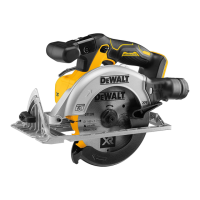
